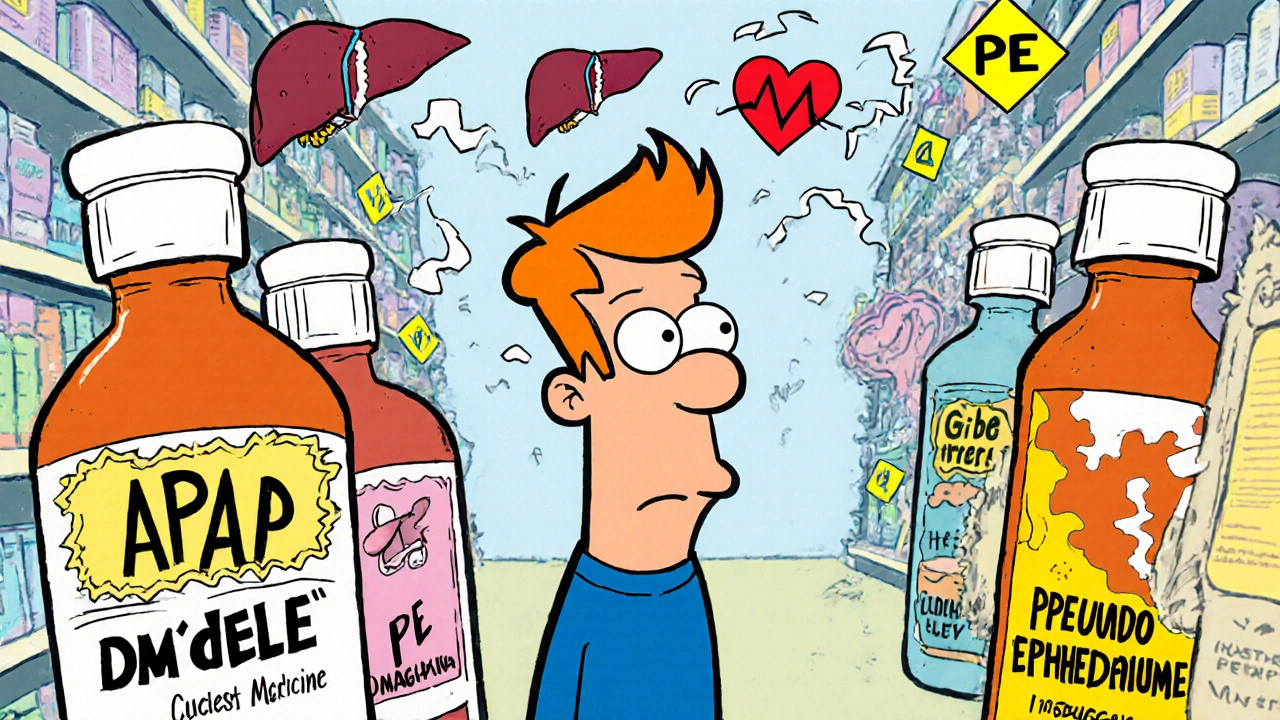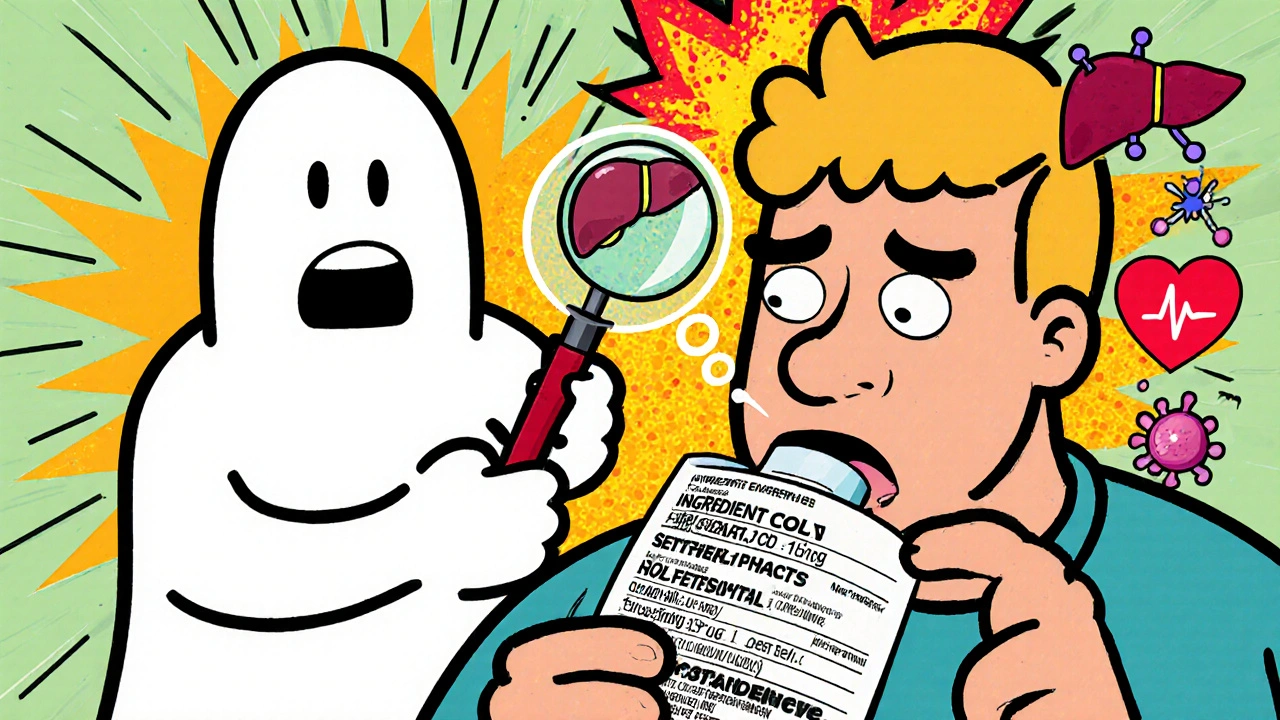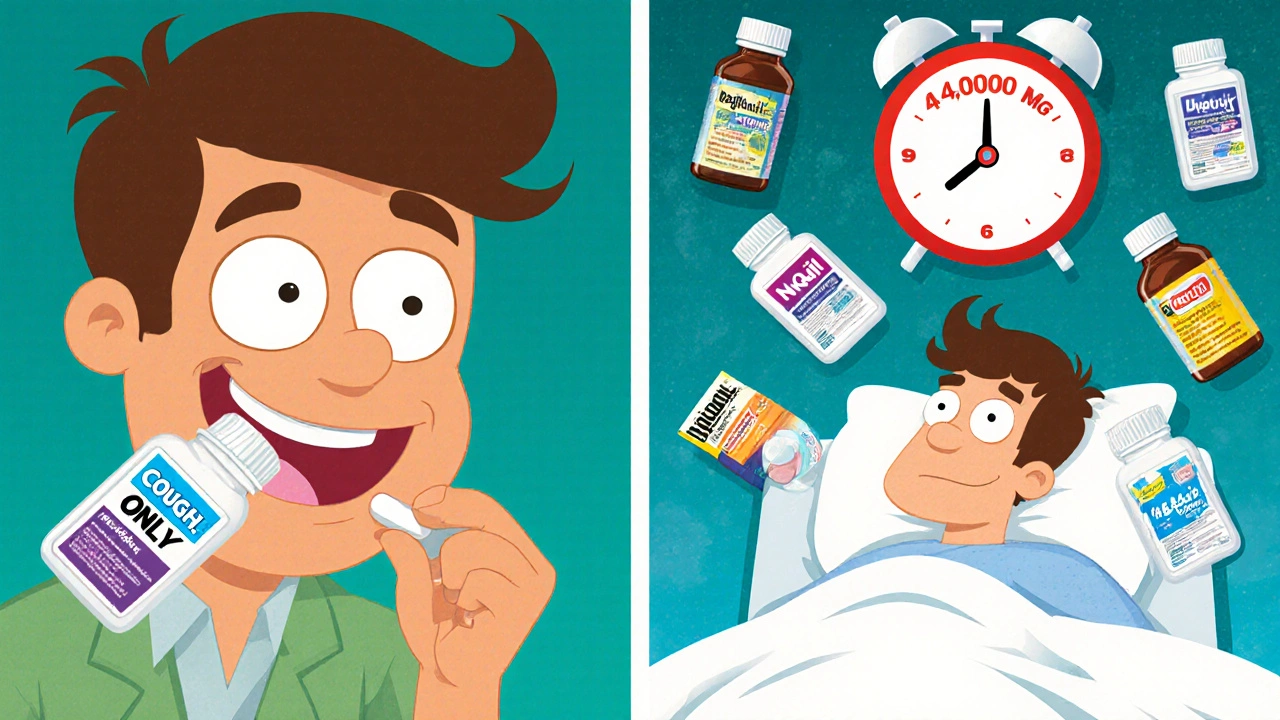
Every year, millions of people reach for a bottle of cold or allergy medicine thinking they’re doing the right thing. They’ve got a runny nose, a headache, and a cough - so they grab the one that promises to fix it all in a single pill. But what they don’t realize is that they might be accidentally overdosing on acetaminophen, raising their blood pressure to dangerous levels, or triggering a rare but life-threatening reaction with their antidepressant. The convenience of combination cold and allergy meds comes with hidden risks - and most people have no idea how serious they are.
What’s Really in Your Cold Medicine?
Most over-the-counter cold and allergy medications aren’t just one drug. They’re a cocktail. You’ll often find four active ingredients packed into one tablet or liquid: an antihistamine to stop the sneezing, a decongestant to clear your nose, a pain reliever for your headache, and a cough suppressant to quiet your throat. These combinations are designed to cover every symptom at once - and they’re hugely popular. In 2022, 65% of all cold and allergy meds sold in the U.S. were combination products.
But here’s the catch: each of these ingredients has its own risks. Acetaminophen (also listed as APAP) is in nearly every multi-symptom product. It’s safe if you take one dose - but if you also take Tylenol for your headache, or a sleep aid that contains it, you can easily hit the 4,000mg daily limit. That’s when liver damage starts. The CDC estimates that 6.7 million Americans accidentally overdose on acetaminophen every year, mostly because they didn’t check the labels of multiple products.
Decongestants like pseudoephedrine and phenylephrine are another big problem. Pseudoephedrine works better - it reduces nasal congestion by about 65%. But it also raises your blood pressure by 8-12 points and speeds up your heart rate. If you already have high blood pressure, this can be dangerous. Phenylephrine is the cheaper alternative found in most store brands. But research shows it barely works at all as a nasal decongestant at standard doses. Still, it’s in everything - and when it’s mixed with acetaminophen, your body absorbs it four times more than normal. That means even a normal dose can trigger dizziness, tremors, or a spike in blood pressure.
The Silent Killer: Acetaminophen Overdose
Acetaminophen is the most common cause of acute liver failure in the U.S. And the worst part? You won’t feel anything until it’s too late. There’s no stomach pain, no vomiting right away. Just fatigue, nausea, and then - hours later - your liver starts shutting down. The FDA has issued multiple warnings about this, and yet, people keep doubling up.
Why? Because the labels are confusing. You’ll see “acetaminophen” on one bottle, “APAP” on another, and “paracetamol” on imported brands. If you don’t know what those abbreviations mean, you’ll think you’re taking two different things. A University of Arizona study found that 68% of people don’t recognize APAP as acetaminophen. That’s why ER visits from accidental overdoses keep climbing.
And it’s not just pain relievers. Sleep aids like NyQuil, ZzzQuil, and even some allergy pills like Benadryl Extra Strength contain acetaminophen too. So if you take a cold med at noon, and then a sleep aid at night thinking you’re just helping with sleep - you’ve just hit your daily limit. No warning. No warning signs. Just damage.
Decongestants and Your Heart
If you have high blood pressure, heart disease, or even just a fast heartbeat, pseudoephedrine and phenylephrine can make things worse. Pseudoephedrine is banned behind the counter in many places because it’s used to make meth - but it’s still sold in some products. Phenylephrine is everywhere now because it’s easier to stock. But studies show it’s ineffective at standard doses. So you’re paying for a placebo that might still raise your blood pressure.
And here’s something most people don’t know: combining phenylephrine with acetaminophen doesn’t just make the decongestant stronger - it makes it more dangerous. Research published in the Journal of Clinical Pharmacology found that when these two are taken together, blood levels of phenylephrine jump to four times higher than when taken alone. That’s not a minor interaction. That’s a pharmacokinetic bomb. One study in New Zealand showed this combo led to 4.1 times more cases of dangerous high blood pressure than acetaminophen alone.
If you’re on blood pressure medication, or if you’ve ever been told to avoid decongestants, don’t assume the label will protect you. The warning might be in tiny print. You need to read the full list of active ingredients - not just the product name.

The Serotonin Trap: Dextromethorphan and Antidepressants
Dextromethorphan (often labeled as DM) is the cough suppressant in Robitussin, Delsym, and many DayQuil and NyQuil products. It’s generally safe - unless you’re taking an SSRI or SNRI antidepressant like sertraline, fluoxetine, or venlafaxine.
When these two are combined, they can trigger serotonin syndrome. It’s rare, but deadly. Symptoms include confusion, rapid heart rate, high fever, muscle rigidity, and seizures. A 2017 study in the Journal of Clinical Psychiatry found the risk jumps by 300% when dextromethorphan is taken with SSRIs. That’s not a small chance. That’s a medical emergency waiting to happen.
And here’s the scary part: most people don’t realize their cold medicine contains dextromethorphan. They see “cough suppressant” and assume it’s harmless. But if you’re on Zoloft or Prozac, you’re playing Russian roulette. The FDA and the American Pharmacists Association both warn against this combo. Yet, it’s still sold on every pharmacy shelf.
What You Should Do Instead
There’s a better way. Instead of grabbing a multi-symptom pill, pick one thing you need most. If you’ve got a stuffy nose, get a plain pseudoephedrine (if you’re cleared by your doctor). If you have a headache, take plain acetaminophen - and stop there. If you’re coughing, use plain dextromethorphan. You’ll avoid the hidden ingredients, the doubled-up doses, and the dangerous interactions.
Here’s how to do it right:
- Check the active ingredients list - not the brand name. Look for APAP, DM, PE, or pseudoephedrine.
- If you’re on any prescription meds - especially antidepressants, blood pressure pills, or thyroid meds - talk to your pharmacist before buying anything.
- Use a free drug interaction checker like WebMD’s or Medisafe. Scan the barcode on the bottle with your phone. It’ll tell you if you’re mixing something dangerous.
- Never take two cold meds at once. Even if they’re different brands. They might have the same ingredients.
- If you’re over 65, have heart problems, or take multiple medications, avoid combination products entirely.
Most people think they’re being smart by using one pill to fix everything. But in reality, they’re just making things riskier. Single-ingredient meds have a 15-20% lower rate of adverse events. That’s not a small difference. That’s the difference between feeling better and ending up in the ER.

What’s Changing in 2025?
The FDA is finally taking action. In March 2023, they announced new labeling rules that will require all combination cold meds to use high-contrast, easy-to-read ingredient lists by December 2024. They’re also reviewing whether phenylephrine should be pulled from the market - because 11 clinical trials show it doesn’t work better than a placebo at the doses used in OTC products.
That means the next time you buy a cold med, the label might look very different. Some brands are already switching. McNeil (the maker of Tylenol) has filed patents for new formulas using caffeine and guaifenesin instead of phenylephrine. If phenylephrine gets removed, you’ll see fewer “sinus” products on the shelves.
But until then - don’t wait for the FDA to protect you. You have to protect yourself.
Real Stories, Real Risks
On Reddit, someone posted: “Took two different cold meds thinking they were different - ended up in ER with high blood pressure.” That’s not an isolated case. Emergency departments across the U.S. see dozens of these every week. A hospital in Arizona reported that 15% of OTC medication-related ER visits involved people mixing cold meds with antidepressants.
Amazon reviews tell the same story. Of over 1,200 reviews for DayQuil Multi-Symptom, 78% say “all-in-one relief” is great. But 32% of the negative reviews mention “unexplained dizziness” or “heart palpitations.” That’s not coincidence. That’s the phenylephrine-acetaminophen interaction in action.
And here’s the kicker: 41% of people admit they don’t check all the ingredients when buying cold medicine. They trust the brand. They trust the packaging. They assume it’s safe. But safety isn’t about trust - it’s about knowing what’s in the bottle.
Bottom Line: Less Is More
The biggest mistake people make is thinking more ingredients means better relief. It doesn’t. It just means more risk. You don’t need a pill that treats your cough, congestion, headache, and allergies all at once. You need one that treats the symptom you can’t ignore.
If you’re unsure - ask your pharmacist. They’re trained to catch these interactions. They see it every day. They’ll tell you if that “cold and allergy” pill is safe for you. And if you’re on any prescription meds, don’t guess. Call your doctor. A 10-minute conversation could prevent a hospital stay.
Combination cold and allergy meds aren’t evil. They’re convenient. But convenience shouldn’t come at the cost of your liver, your heart, or your life. Read the label. Know the ingredients. Stick to one thing at a time. Your body will thank you.
Can I take allergy medicine with a cold medicine?
Only if you check the active ingredients. Many allergy meds already contain decongestants and pain relievers. Taking them with a cold medicine often means doubling up on acetaminophen, pseudoephedrine, or dextromethorphan - which can lead to overdose or dangerous interactions. Always compare ingredient lists before combining.
Is phenylephrine safe to use?
Current evidence shows phenylephrine, at the 10mg dose found in most OTC products, doesn’t work better than a placebo as a decongestant. But it still raises blood pressure and interacts dangerously with acetaminophen. The FDA is reviewing its effectiveness and may remove it from the market. Until then, avoid it if you have high blood pressure or heart issues.
What’s the safest OTC cold medicine?
The safest option is a single-ingredient medicine that targets just your worst symptom. For congestion, use plain pseudoephedrine (if cleared by your doctor). For pain or fever, use plain acetaminophen. For cough, use plain dextromethorphan. Avoid anything labeled “multi-symptom” unless you’ve confirmed there are no overlapping ingredients with other meds you’re taking.
Can I take cold medicine if I’m on antidepressants?
Avoid any cold medicine containing dextromethorphan (DM) if you’re on an SSRI or SNRI antidepressant. This combo can cause serotonin syndrome - a potentially fatal reaction. Also avoid pseudoephedrine if you’re on MAOIs. Always check with your doctor or pharmacist before taking any OTC cold med while on antidepressants.
How do I know if I’ve taken too much acetaminophen?
There are no immediate symptoms. You might feel tired, nauseous, or lose your appetite - but these signs can take 12-24 hours to appear. By then, liver damage may already be happening. If you’ve taken more than 4,000mg in 24 hours - even if you feel fine - seek medical help immediately. Don’t wait for symptoms.




Ravi boy
November 19, 2025bro i just took that nyquil last week and felt weird af no idea it had acetaminophen and dextro in it
Matthew Karrs
November 20, 2025the fda is in on it. they let phenylephrine stay because big pharma pays them. same with acetaminophen limits. they want you in the er so they can bill you $12k for a 2 hour visit. you think this is about safety? nah. it's about profit.
Matthew Peters
November 20, 2025oh my god i just checked my medicine cabinet and found three different bottles with APAP in them. i've been taking one at night for sleep and another in the morning for headaches. i thought they were different. now i'm sweating. my liver is probably screaming. thanks for this. i'm throwing all my multi-symptom crap out.
Liam Strachan
November 21, 2025really helpful breakdown. i always just grab whatever's on sale but now i'm going to start reading labels properly. my mum has high blood pressure and i'll make sure she avoids the pseudo stuff. thanks for keeping us safe!
Gerald Cheruiyot
November 22, 2025we live in a world where convenience is worshipped over caution. we want one pill for everything because we're too busy to think. but our bodies aren't apps. you can't just tap and fix. you have to understand what you're putting in. this isn't just advice. it's a survival skill in modern america
Michael Fessler
November 23, 2025just a quick note: phenylephrine's bioavailability is <1% when taken orally at 10mg. it's literally a placebo with a side of hypertensive risk. the real decongestant is pseudoephedrine - which is why it's behind the counter. if your pharmacy gives you phenylephrine, they're either cheap or lazy. check the label. if it says PE - walk away. get the pseudo if you're cleared. and always check for APAP - it's in everything. even the 'allergy' ones.
daniel lopez
November 25, 2025you think this is bad? wait till you find out the FDA banned ephedrine because it was too effective and now they replaced it with phenylephrine which doesn't work but still kills people. this is all about control. they want you dependent on their drugs. they don't care if you die. they care if you keep buying. and they know you're too dumb to read labels so they keep putting the poison in plain sight. wake up.
Nosipho Mbambo
November 25, 2025I’ve been taking ZzzQuil for years because I thought it was just for sleep… and now I find out it has acetaminophen?!?!!? I’ve been on blood pressure meds for 7 years! I’ve been doing this wrong for YEARS! I’m going to the pharmacy tomorrow. I need to talk to someone. I feel so stupid.
Katie Magnus
November 26, 2025how is this even a thing? people are dying because they can't read? this isn't a medical issue. it's a cultural collapse. we raised a generation that thinks 'just take a pill' is a lifestyle. the real problem isn't the meds. it's the people who think convenience beats knowledge. we're all just one bad combo away from a funeral.
Bharat Alasandi
November 26, 2025bro this is gold. i used to grab those multi-symptom pills like candy. now i only get single-ingredient stuff. if i got a headache i take tylenol. if i got a stuffy nose i take sudafed (behind counter but worth it). no more guessing. no more ER visits. your body deserves better than a chemical lottery.
Kristi Bennardo
November 28, 2025This article is dangerously oversimplified. You are encouraging self-diagnosis and the abandonment of pharmaceutical innovation. Combination medications exist for a reason: efficiency, compliance, and cost-effectiveness. To suggest that patients should manually piece together their own regimens is irresponsible. Pharmacists are trained professionals - they should be consulted, not replaced by Reddit advice.
Shiv Karan Singh
November 28, 2025lol you think you're the first to tell people to read labels? everyone knows this. but people still buy it because they're lazy and addicted to quick fixes. this isn't about medicine. it's about human nature. we want magic pills. we don't want to think. so we die. and then the next person does the same thing. it's not a system failure. it's a species failure. 🤷♂️